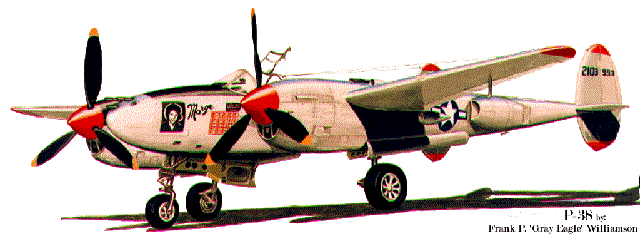Lockheed P-38 "Lightning"

"MARGE" by Frank P. "Grey Eagle" Williams.
The Germans called it the "Der Gabelschwanzteufel*". The Americans called it the "Flying Bedstead". The fact is this venerable plane proved invaluable in a multitude of roles from ground attack to air interdiction and dogfighting. The 2 top leading American aces of WWII both flew P-38 "Lightnings." MAJ Thomas McGuire scored 38 kills, and MAJ Richard Bong had 40 kills in his Lightning which he named Marge, after his wife. Both pilots were awarded the Medal of Honor, making them two of 8 USAAF fighter pilots so decorated. The P-38 had a superior combat radius which made it an ideal fighter/interceptor in the PTO. This was a leading factor in choosing a squadron for the long range interception of the Japanese Admiral Yamamoto's (code named "DILLINGER") transport. The task was assigned to the Lightnings of the 339th FS.
In 1937 the US Army specifications called for an aircraft capable of 360 mph at a medium altitude with an endurance of 1 hour. The first prototype, XP-38, was accepted by the Army
early in 1939. This unconventional aircraft had two Allison, turbocharged engines with counter rotating props, twin booms and a central fuselage. On a test transcontinental flight to New York
it broke all speed records. Unfortunately, it crashed on landing.
Within a year the Army placed an order for 13 aircraft. The British ordered 667 of an export version, and made further modifications which included removal of the turbochargers and counter rotating
props. As a result, the aircraft performed miserably and all the aircraft were removed from the RAF inventory! The only thing to survive that program was the name the British gave it: LIGHTNING.

In 1941 the USAAF accepted its first operational version, the P-38D. This design incorporated laminar flow wings, Fowler flaps, and leading edge intercoolers. The counter rotation
of the props allowed for uniform roll rates in both directions. Single engine planes suffered in this regard, since they have to fight the engine torque when they turn in the direction of the
prop. Unfortunately, the size and configuration of the 38 gave it a poor roll rate from the start. This aircraft was perhaps the quietest due to the design of the exhaust system and the displacement
of the exhaust vents.
The 38 was also the first aircraft to approach the speed of sound in a dive. This created a shock wave over the wing which moved rearward as the speed approached 1 mach. This had dire consequences
since the shock wave would lock the control surfaces. This phenomenon is called compression. A dive break was later added in the H model to control speed. Another quirk of the design involved
the oil coolers. The design was so efficient that the oil became very viscous at high altitudes. This resulted in turbocharger overspeeds or engine failure.
There were many variants of the 38. This included many reconnaissance versions. Some were equipped with Bomb Through Overcast (BTO) radars. One version even carried a bombardier using a Norden
bombsight in place of the gun suite. There was also a night interceptor equipped with air to air radar.
P-38J Statistics.
- Wingspan:15.85 m (52').
- Length: 11.53 m (37' 10").
- Wing area: 30.43 square meters (327.5 square feet).
- Weight: 5797 kg (12780 lbs) empty, 9798 kg (21600 lbs) maximum.
- Engines: 2 Allison V-1710 V12, liquid cooled, counter rotating. 1425 hp.
- Speed: 676 km/h (420 mph) max in level flight.
- Service ceiling: 13410 m (44000').
- Range: 1891 km (1175 miles) on internal load, 3637 km (2260 miles) with external tanks.
- Armament: 1 M2C cannon, four 12.7 mm (1/2") machine guns, 2 726 kg (1600 lbs) bombs.
* Pronounced Gah-bell shvantz toy-ful and means Forked-tailed Devil.